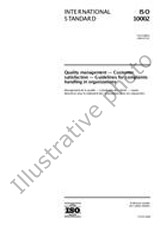We need your consent to use the individual data so that you can see information about your interests, among other things. Click "OK" to give your consent.

ISO 9022-6:2015-ed.2.0
Optics and photonics — Environmental test methods — Part 6: Dust
Automatically translated name:
Optics and photonics -- Environmental test methods -- Part 6: Dust
STANDARD published on 26.2.2015
The information about the standard:
Designation standards: ISO 9022-6:2015-ed.2.0
Publication date standards: 26.2.2015
SKU: NS-580947
The number of pages: 4
Approximate weight : 12 g (0.03 lbs)
Country: International technical standard
Category: Technical standards ISO
The category - similar standards:
Annotation of standard text ISO 9022-6:2015-ed.2.0 :
Description / Abstract: ISO 9022-6:2015 specifies the methods relating to the environmental tests of optical instruments including additional assemblies from other fields (e.g. mechanical, chemical, and electronic devices), under equivalent conditions, for their ability to resist the influence of blowing dust. The purpose of testing is to investigate to what extent the optical, climatic, mechanical, chemical, and electrical (including electrostatic) performance characteristics of the specimen are affected by blowing dust, especially with a view to malfunctions of moving parts (such as sliding surfaces, bearings, contacts, operating controls, gears) or unacceptable wear of surfaces. This test is not intended to determine the wear resistance to coarse dust.
We recommend:
Technical standards updating
Do you want to make sure you use only the valid technical standards?
We can offer you a solution which will provide you a monthly overview concerning the updating of standards which you use.
Would you like to know more? Look at this page.



 Cookies
Cookies
